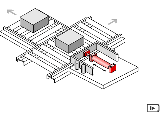[165] Exercise: Roller conveyor (flow resistance)
 Steel blocks are
transported on a roller conveyor. A hydraulic transfer station
makes it possible to transfer blocks from one track to another. A
pressure of at least 30 bar is required for the transfer of
blocks by means of hydraulic cylinders. Every component through
which the hydraulic fluid flows represents a resistance and
causes a constant pressure loss. The question is, what pressure
is to be set at the pressure relief valve.
Steel blocks are
transported on a roller conveyor. A hydraulic transfer station
makes it possible to transfer blocks from one track to another. A
pressure of at least 30 bar is required for the transfer of
blocks by means of hydraulic cylinders. Every component through
which the hydraulic fluid flows represents a resistance and
causes a constant pressure loss. The question is, what pressure
is to be set at the pressure relief valve.
The total resistance is the sum of all the individual resistances. The resistance must be determined separately for the advance and return strokes. The overall balances do not include data for the pressure losses at the 4/2-way valve. These can be determined from the flow characteristic for the 4/2-way valve, based on a volumetric flow of 8 l/min. In the calculation, allowance must be made for the resistance of the directional control valve on the inlet and outlet sides respectively. Allowance must also be made for the pressure intensification factor of 2:1 in the case of the differential cylinder. This enables values to be calculated as shown in the solution figure. In the case of the advance stroke, 6 bar hysteresis for the PRV (see exercise 164) must be added to the calculated 42.5 bar in order to ensure that the opening pressure is higher than the required operating pressure. The value finally chosen is 50 bar in order to make allowance for unknown variables such as pipe elbows and the static friction in the cylinder.
In order to keep pressure losses in large installations to a minimum, it is advisable to select valves on the basis of their flow characteristics. It is better to select a valve which is one size too large than to accept large pressure losses. This furthermore reduces wear resulting from cavitation in the valves.

